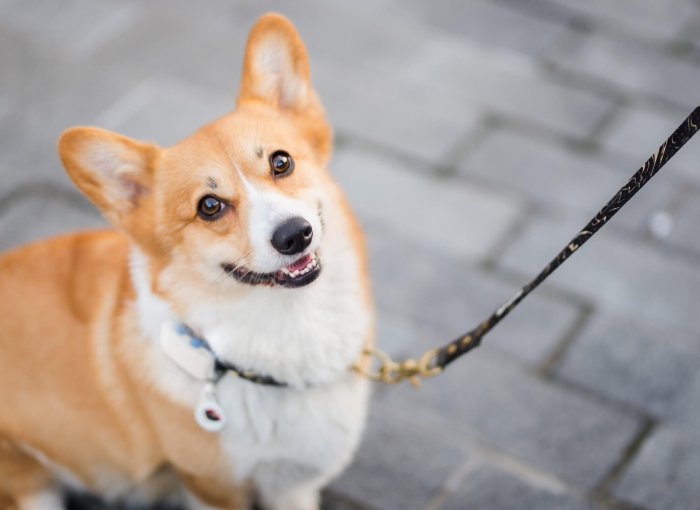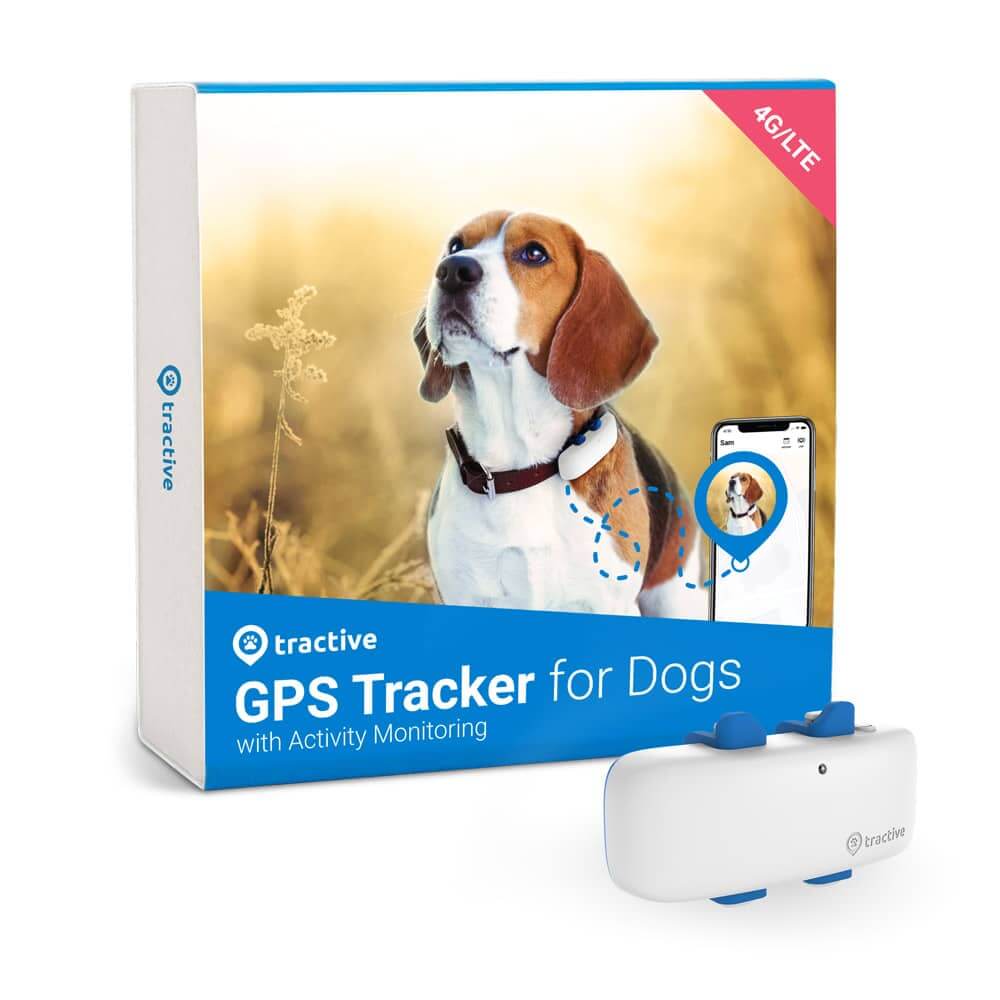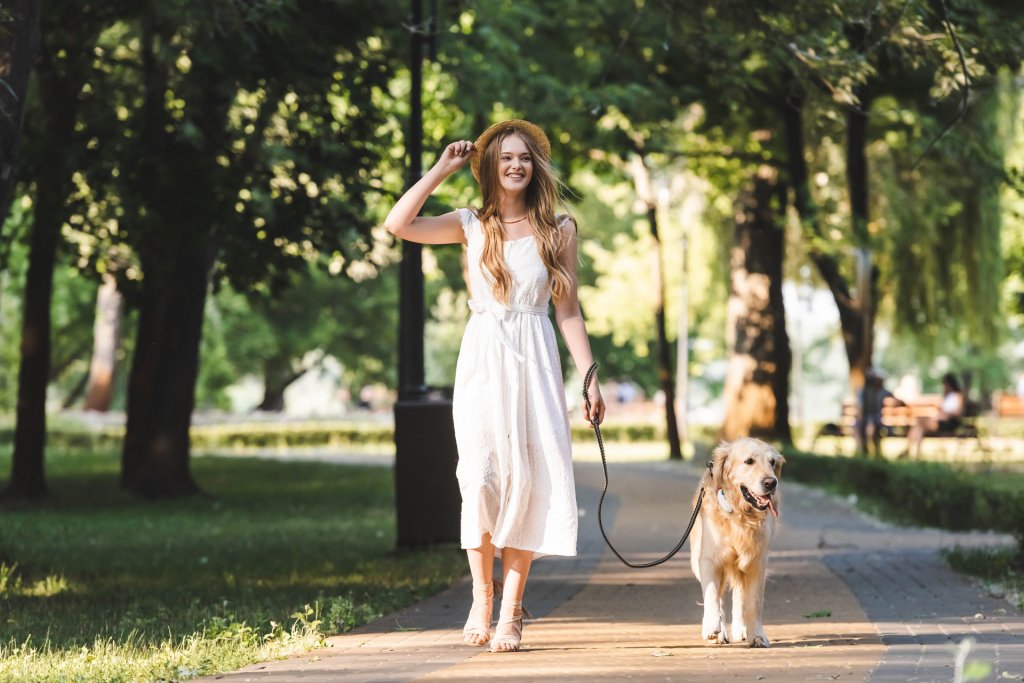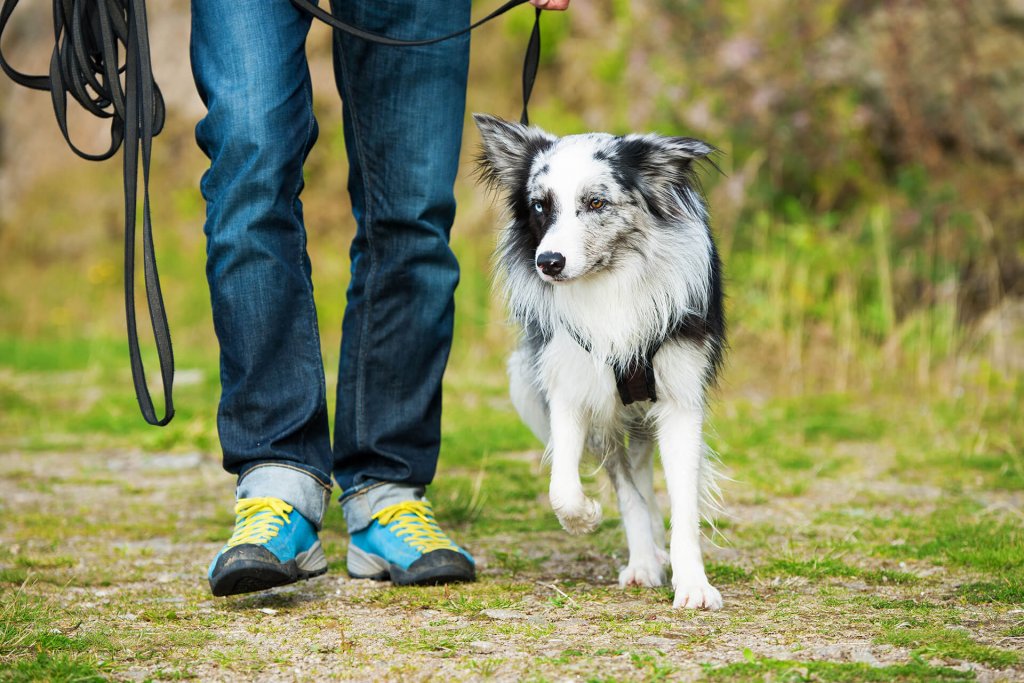The Guide To Leash Training A Puppy Or Dog
Leash training is an important milestone in every dog's (and dog parent's) life. Learn how to get your puppy walking on the leash in no time, with these tips, for more peaceful walks together.

If you’ve ever met one, you probably know dogs don’t naturally know how to walk on a leash – they have to be trained. It’s important for you and your dog’s safety, as well as that of the people around you. Not to mention the squirrels your dog would be chasing otherwise! Since all dogs have a prey drive which can cause them to run away and get lost, leash training a puppy or dog is essential. Despite what you or your pup may want, a dog can’t always run around off-leash. So learn how to leash train your puppy or dog the easy way.
- Why is dog leash training important?
- At what age should you start leash training a puppy?
- What you’ll need for leash training a puppy or dog:
- Introducing the collar and leash
- Dog Leash Training Techniques
- How to fix common issues in the dog leash training process
- When is it necessary to use a leash?
- Final tips on leash training a puppy or dog
- More dog leash training support

Always know where your dog is
Follow every step in real-time with unlimited range. Get alerts if they wander too far. Keep them happy & healthy with Wellness Monitoring. And let others – like walkers or sitters – keep an eye on your dog too.
Why is dog leash training important?
As mentioned, training your dog to walk on a leash is really important. So let’s take a moment here to appreciate just how very essential it is. Here are several reasons why leash training a puppy or dog is crucial for every dog parent:
- If your dog pulls on the leash, you’ll probably get frustrated. This frustration may cause you to lose your temper, or resent having to walk the dog in the first place. You might even use punishment. And all these things have a negative impact on your relationship with your furry friend.
- Your dog will get frustrated too if they always feel like they “have to” strain against their leash. This could lead to your dog behaving aggressively, or simply getting stressed out. In this state, your dog is more likely to threaten other dogs1.
- Pulling on your dog’s leash constantly can have negative consequences for their health. It could cause injury to their neck, and put stress on their joints.
- The tension in a leash (loose vs tight) is important because it helps communicate with your dog. If the leash suddenly goes taut, it may mean your dog is frightened, or ready to fight. Similarly, how you hold the leash will communicate to your dog how you are feeling.
- Finally, dog leash training is important because we love our dogs and don’t want them to come into harm’s way. (Discover how Tractive GPS helps.)
Luckily, training a dog to walk on a leash can be easier than you think.

At what age should you start leash training a puppy?
As with all types of dog training, it’s most effective if you start while your dog is still a puppy. In fact you can already start leash training a puppy at four to six weeks old2. Like children, puppies are fast learners, while it can be more difficult to teach an old dog new tricks (although not impossible).
What you’ll need for leash training a puppy or dog:
To start leash training your dog, you’ll need:
- Leash – a 4-6 foot (around 1-2m) and non-retractable leash is recommended3 when getting started
- Collar or harness – a buckle or Martingale collar, head halter, or any type of harness will do
- Treats – go with your dog’s favorite
- GPS dog tracker (optional) – untrained puppies and dogs can bolt at any moment – with a tracker, you’ll be ready and can find your buddy in seconds
- Patience – that, and a positive attitude, are key ingredients
Introducing the collar and leash
The first step in dog leash training is to let your dog get used to wearing the collar or harness, followed by the leash. Make sure your dog or puppy can wear their new accessory comfortably – it should not be too heavy or distracting.
Next, attach the leash to the collar or harness while your pup is inside, and let them get acquainted with it. Focus your dog’s attention elsewhere – not on the collar or leash – so that wearing becomes second nature.
Let your dog wear the collar and leash for short periods of time while you play with them and offer treats. Your pup may end up loving “collar and leash time” because it represents food and fun.
Dog Leash Training Techniques
Once you have all your gear, you’re ready to start leash training your puppy or dog. Below are two of the most common dog leash training methods: the loose leash walking and heel training techniques.
1) Train your dog to walk on a loose leash
With this option, you train your dog to walk on the leash so that there is no tension on it. You don’t pull your dog, and they don’t pull you. Instead, your dog is trained to walk within the length of the leash. Follow the steps below to train your dog to walk on a loose leash:
- Start practicing inside the house – at first, without the leash.
- Call your dog to your side, and then reward them with a treat.
- Walk forward a few steps, engaging your dog along the way. When they meet you at your side again, give another treat.
- Repeat this exercise walking around your house, until your dog has caught on and is eagerly awaiting their next treat.
- Repeat these steps, but this time with the collar or harness and leash on.
- Once your dog has mastered loose leash walking inside, take them outdoors. Practice in a distraction-free area until your dog is a pro!4
(And of course, don’t forget to praise your dog for being such a good boy or girl)
2) Train your dog to heel
Another dog leash training option is known as heeling. With this technique, your dog always walks at your left or right side, whichever is best for you. Your dog should keep to your pace, and stop when you stop. Heeling is best used in special circumstances when your dog needs to stay nearby. For your daily dog walks, it may be too limiting to their movement and exercise.

Heel training your dog is similar to loose leash training your dog, except you’ll want to make extra sure your dog stays by your side:
- Lure your dog to your left side with a tasty treat. Reward them when they’re next to you.
- To keep your dog at your side, continue rewarding them frequently without moving.
- Take a step forward, lure your dog once more with a treat, and reward them once they’re at your side.
- Continue to do this as you move around – but only reward your dog when they are at your side. If your dog gets side-tracked – do not reward, but guide them back to your side and start again.
- Mix things up a bit. For example, pick up the pace, or stop randomly – and only reward your dog when they’re at your side.
- Once your dog consistently stays by your side, you can teach them the “heel” cue. Say it once and reward your dog when they come to your side.
- When you’re ready to stop, give your dog a release cue like, “all done” and throw them a treat in another direction.
- Repeat the above outdoors until your dog has mastered heeling.
How to fix common issues in the dog leash training process
Your dog might be uncooperative at some point during the leash training process. But don’t let pulling, lunging, or barking let you lose your cool. Follow these tips while your dog is still learning their best leash walking etiquette:
| If your dog does this… | Do this.. |
| Plays tug-o-war, pulls on the leash | Stop walking immediately. Don’t yank them back over to you with the leash. Just call them back over to you, praise them when they come, and then continue walking. Don’t keep walking when your puppy is pulling on the leash as it may hurt them. Pulling is a sign that your dog needs more exercise. |
| Lunges – for example, after a bird or squirrel | Redirect your dog’s attention with a treat, if possible, before they lunge. Increase the distance between your dog and the subject of their attention. Stay alert and inform yourself about your dog’s prey drive. |
| Barks excessively | Make sure your dog gets enough physical exercise and mental stimulation – otherwise they may be more prone to barking. Play games with them, train them new commands, try treat puzzles. Set a daily activity goal with Tractive GPS DOG Activity Monitoring and smash it every day. |
When is it necessary to use a leash?
As a dog parent, it’s your responsibility to inform yourself of and follow any laws in your local area related to dogs. For example, the paragraph below explains some of the regulations regarding dogs in Franklin County, Ohio. Visit your local government’s website to find the local dog laws in your area. And of course, be sure to abide by the relevant dog laws when you are traveling with your dog.

Play it safe – leash up: Disregarding dog leash requirement laws can have serious consequences – including steep fines and potentially even jail time.
In addition to obeying dog leash laws, it’s a good idea to use a dog leash:
- when your dog has not yet been trained
- during spring and wildlife breeding season
- if your dog shows aggression or has other behavioral issues
- in crowded or high-traffic areas
- any time you’re worried about your dog running away
In addition to a leash, a Tractive GPS dog tracker can be you and your dog’s best friend. With it, you can track your dog anytime, in real time, no matter how far away they wander.
Final tips on leash training a puppy or dog
Remember, leash training a puppy or dog takes time, patience and plenty of positive reinforcement. So whatever you do, try to stay calm and be patient with your dog. With the tips below and a consistent effort, together you will master the art of walking on the leash in no time.
- Leash training is an essential part of every dog-human bond
- You can start leash training your puppy as early as 4 weeks old
- First, get your dog used to the collar or harness and leash
- Start training indoors before you take things outdoors
- Let your dog come to you, then reward them with treats for good behavior
- Never pull on the leash
- Use a GPS dog tracker for extra security and peace of mind
- Be patient, positive and kind to your dog throughout the leash training process
More dog leash training support
Need more support on your dog leash training journey? Check out the video below from the professionals at McCann Dog Training: 5 Reasons Why Your Leash Walking Training Isn’t Working:




